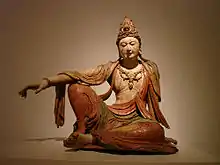Five Tathāgatas
In Mahayana and Vajrayana Buddhism, the Five Tathāgatas (Sanskrit: पञ्चतथागत, pañcatathāgata; Chinese: 五方佛; pinyin: Wǔfāngfó) or Five Wisdom Tathāgatas (Chinese: 五智如来; pinyin: Wǔzhì Rúlái), the Five Great Buddhas and the Five Jinas (Sanskrit for "conqueror" or "victor"), are five Buddhas which are often venerated together. Various sources provide different names for these Buddhas, though the most common today are: Akshobhya, Ratnasambhava, Vairocana, Amitābha, and Amoghasiddhi.[1]
_statues_of_the_Five_Tathagathas_(%E4%BA%94%E6%96%B9%E4%BD%9B_W%C7%94f%C4%81ngf%C3%B3)_or_Five_Wisdom_Buddhas_(%E4%BA%94%E6%99%BA%E5%A6%82%E6%9D%A5_W%C7%94zh%C3%AC_R%C3%BAl%C3%A1i)%252C_in_Shanhua_Temple_(%E5%96%84%E5%8C%96%E5%AF%BA)_in_Datong%252C_Shanxi%252C_China.jpg.webp)
They are sometimes seen as emanations and representations of the five qualities of the Adi-Buddha or "first Buddha", which is associated with the Dharmakāya.[1] Some sources also include this "first Buddha" as a sixth Buddha along with the five.[1]
These five Buddhas are a common subject of Vajrayana mandalas and they feature prominently in various Buddhist Tantras. The Five Tathagathas are the primary object of realization and meditation in Shingon Buddhism, a school of Vajarayana Buddhism founded in Japan by Kūkai.
In Chinese Buddhism, veneration of the five Buddhas have dispersed from Chinese Esoteric Buddhism into the other Chinese Buddhist traditions like Chan and Tiantai. They are regularly enshrined in many Chinese Buddhist temples and regularly invoked in rituals, such as the Liberation Rite of Water and Land and the Yogacara Flaming Mouth ceremony (瑜伽焰口法會), as well as prayers and chants.[2][3]
They are also sometimes called the "dhyani-buddhas", a term first recorded in English by Brian Houghton Hodgson, a British Resident in Nepal,[4] in the early 19th century, and is unattested in any surviving traditional primary sources.[5]
Origin
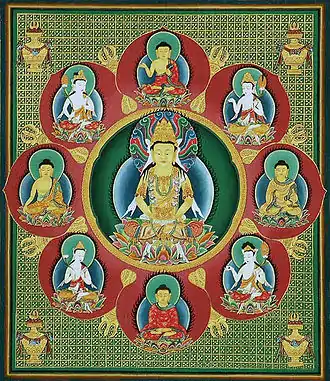
The Five Wisdom Buddhas are a development of the Buddhist Tantras, and later became associated with the trikaya or "three body" theory of Buddhahood. While in the Tattvasaṃgraha Tantra there are only four Buddha families, the full Diamond Realm mandala with five Buddhas first appears in the Vajrasekhara Sutra.[1]
The Vajrasekhara also mentions a sixth Buddha, Vajradhara, "a Buddha (or principle) seen as the source, in some sense, of the five Buddhas."[1]
The Five Buddhas are aspects of the dharmakaya "dharma-body", which embodies the principle of enlightenment in Buddhism.
Initially, two Buddhas appeared to represent wisdom and compassion: Akshobhya and Amitābha. A further distinction embodied the aspects of power, or activity, and the aspect of beauty, or spiritual riches. In the Golden Light Sutra, an early Mahayana text, the figures are named Dundubishvara and Ratnaketu, but over time their names changed to become Amoghasiddhi, and Ratnasambhava. The central figure came to be called Vairocana.
When these Buddhas are represented in mandalas, they may not always have the same colour or be related to the same directions. In particular, Akshobhya and Vairocana may be switched. When represented in a Vairocana mandala, the Buddhas are arranged like this:
| Amoghasiddhi (North) | ||
| Amitābha (West) | Vairocana (Principal deity/meditator) | Akshobhya (East) |
| Ratnasambhava (South) |
The Five Families or Divisions and their qualities
There is an expansive number of associations with each element of the five Buddhas mandala, so that the mandala becomes a cipher and mnemonic visual thinking instrument and concept map; a vehicle for understanding and decoding the whole of the Dharma. Each Buddha Family or Division has numerous symbols, secondary figures (like bodhisattvas, protectors, etc.), powers and aspects.
Some of the associations include:
| Family (Kula) | Buddha | Colour ← Element → Symbolism | Cardinality → Wisdom → Attachments → Gestures | Means → Maladaptation to Stress | Season | Wisdom |
|---|---|---|---|---|---|---|
| Buddha Family | Vairocana | white ← space → wheel | center → all accommodating → rūpa → Teaching the Dharma | Turning the Wheel of Dharma → ignorance, delusion | n/a | 法界体性智: The wisdom of the essence of the dharma-realm meditation mudra.[6] |
| Karma Family | Amoghasiddhi | green ← air, wind → viśvavajra | north → all accomplishing → mental formation, concept → fearlessness | protect, destroy → envy, jealousy | spring | 成所作智: The wisdom of perfect practice. |
| Padma (Lotus) Family | Amitābha | red ← fire → lotus | west → inquisitive → perception → meditation | magnetize, subjugate → selfishness, attachment | summer | 妙観察智: The wisdom of observation. |
| Ratna (Jewel) Family | Ratnasambhava | gold/yellow ← earth → jewel | south → equanimous → feeling → giving | enrich, increase → pride, greed | autumn | 平等性智: The wisdom of equanimity. |
| Vajra Family | Akṣobhya | blue ← water → sceptre, vajra | east → nondualist → vijñāna → humility | pacify, accept → aggression, aversion | winter | 大円鏡智: The wisdom of reflection. |
The five Tathāgathas are protected by five Wisdom Kings, and in China and Japan are frequently depicted together in the Mandala of the Two Realms. In the Śūraṅgama santra revealed in the Śūraṅgama sutra, an especially influential dharani in the Chinese Chan tradition, the five Tathāgathas are mentioned as the hosts of the five divisions which controls the vast demon armies of the five directions.[7]
- In the East is the Vajra Division, hosted by Akṣobhya
- In the South, the Jewel-creating Division, hosted by Ratnasaṃbhava
- In the center, the Buddha Division, hosted by Vairocana
- In the West, the Lotus Division, hosted by Amitābha
- In the North, the Karma Division, hosted by Amoghasiddhi
In East Asia, they each are also often depicted with consorts, and preside over their own pure lands, with the aspiration to be reborn into a pure land being the central point of Pure Land Buddhism. Although all five Buddhas have pure lands, it appears that only Sukhavati of Amitābha, and to a much lesser extent Abhirati of Akshobhya (where great masters like Vimalakirti and Milarepa are said to dwell) attracted aspirants.
| Buddha (Skt) | Consort | Bodhisattva | Pure land | Bīja |
|---|---|---|---|---|
| Vairocana | Dharmadhatvishvari | Samantabhadra | Akaniṣṭha-Ghanavyūha (Center) | Om |
| Akṣobhya | Locanā | Vajrapani | Abhirati (East) | Hum |
| Amitābha | Pandara [8] | Avalokiteśvara | Sukhāvatī (West) | Hrih |
| Ratnasaṃbhava | Mamaki [9] | Ratnapani | Śrīmat (South) | Tram |
| Amoghasiddhi | Green Tara[10][11] | Viśvapāni | Karmaprasiddhi[12] or Prakuṭā[13] (North) | Ah |
Gallery
%252C_one_of_the_Five_Tathagathas_(%E4%BA%94%E6%96%B9%E4%BD%9B_W%C7%94f%C4%81ngf%C3%B3)_or_Five_Wisdom_Buddhas_(%E4%BA%94%E6%99%BA%E5%A6%82%E6%9D%A5_W%C7%94zh%C3%AC_R%C3%BAl%C3%A1i)_at_Shanhua_Temple_(%E5%96%84%E5%8C%96%E5%AF%BA)_in_Datong%252C_Shanxi%252C_China.jpg.webp)
%252C_one_of_the_Five_Tathagathas_(%E4%BA%94%E6%96%B9%E4%BD%9B_W%C7%94f%C4%81ngf%C3%B3)_or_Five_Wisdom_Buddhas_(%E4%BA%94%E6%99%BA%E5%A6%82%E6%9D%A5_W%C7%94zh%C3%AC_R%C3%BAl%C3%A1i)_at_Shanhua_Temple_(%E5%96%84%E5%8C%96%E5%AF%BA)%252C_Datong%252C_Shanxi%252C_China.jpg.webp)
%252C_one_of_Five_Tathagathas_(%E4%BA%94%E6%96%B9%E4%BD%9B_W%C7%94f%C4%81ngf%C3%B3)_or_Five_Wisdom_Buddhas_(%E4%BA%94%E6%99%BA%E5%A6%82%E6%9D%A5_W%C7%94zh%C3%AC_R%C3%BAl%C3%A1i)_at_Shanhua_Temple_(%E5%96%84%E5%8C%96%E5%AF%BA)%252C_Shanxi%252C_China.jpg.webp)
%252C_one_of_Five_Tathagathas_(%E4%BA%94%E6%96%B9%E4%BD%9B_W%C7%94f%C4%81ngf%C3%B3)_or_Five_Wisdom_Buddhas_(%E4%BA%94%E6%99%BA%E5%A6%82%E6%9D%A5_W%C7%94zh%C3%AC_R%C3%BAl%C3%A1i)_at_Shanhua_Temple_(%E5%96%84%E5%8C%96%E5%AF%BA)_in_Shanxi%252C_China.jpg.webp)
%252C_one_of_the_Five_Tathagathas_(%E4%BA%94%E6%96%B9%E4%BD%9B_W%C7%94f%C4%81ngf%C3%B3)_or_Five_Wisdom_Buddhas_(%E4%BA%94%E6%99%BA%E5%A6%82%E6%9D%A5_W%C7%94zh%C3%AC_R%C3%BAl%C3%A1i)_at_Shanhua_Temple_(%E5%96%84%E5%8C%96%E5%AF%BA)_in_Datong%252C_Shanxi%252C_China.jpg.webp)
%252C_one_of_the_Five_Tathagathas_(%E4%BA%94%E6%96%B9%E4%BD%9B_W%C7%94f%C4%81ngf%C3%B3)_or_Five_Wisdom_Buddhas_(%E4%BA%94%E6%99%BA%E5%A6%82%E6%9D%A5_W%C7%94zh%C3%AC_R%C3%BAl%C3%A1i)_at_Huayan_Temple_(%E8%8F%AF%E5%9A%B4%E5%AF%BA_or_%E5%8D%8E%E4%B8%A5%E5%AF%BA)%252C_Shanxi%252C_China.jpg.webp)
%252C_one_of_the_Five_Tathagathas_(%E4%BA%94%E6%96%B9%E4%BD%9B_W%C7%94f%C4%81ngf%C3%B3)_or_Five_Wisdom_Buddhas_(%E4%BA%94%E6%99%BA%E5%A6%82%E6%9D%A5_W%C7%94zh%C3%AC_R%C3%BAl%C3%A1i)_at_Huayan_Temple_(%E5%8D%8E%E4%B8%A5%E5%AF%BA)%252C_Shanxi%252C_China.jpg.webp)
%252C_one_of_Five_Tathagathas_(%E4%BA%94%E6%96%B9%E4%BD%9B_W%C7%94f%C4%81ngf%C3%B3)_or_Five_Wisdom_Buddhas_(%E4%BA%94%E6%99%BA%E5%A6%82%E6%9D%A5_W%C7%94zh%C3%AC_R%C3%BAl%C3%A1i)%252C_Huayan_Temple_(%E5%8D%8E%E4%B8%A5%E5%AF%BA)%252C_Shanxi%252C_China.jpg.webp)
%252C_one_of_Five_Tathagathas_(%E4%BA%94%E6%96%B9%E4%BD%9B_W%C7%94f%C4%81ngf%C3%B3)_or_Five_Wisdom_Buddhas_(%E4%BA%94%E6%99%BA%E5%A6%82%E6%9D%A5_W%C7%94zh%C3%AC_R%C3%BAl%C3%A1i)_at_Huayan_Temple_(%E5%8D%8E%E4%B8%A5%E5%AF%BA)%252C_Shanxi%252C_China.jpg.webp)
%252C_one_of_the_Five_Tathagathas_(%E4%BA%94%E6%96%B9%E4%BD%9B_W%C7%94f%C4%81ngf%C3%B3)_or_Five_Wisdom_Buddhas_(%E4%BA%94%E6%99%BA%E5%A6%82%E6%9D%A5_W%C7%94zh%C3%AC_R%C3%BAl%C3%A1i)_at_Huayan_Temple_(%E8%8F%AF%E5%9A%B4%E5%AF%BA_or_%E5%8D%8E%E4%B8%A5%E5%AF%BA)%252C_Datong%252C_Shanxi%252C_China.jpg.webp)
_or_Five_Wisdom_Buddhas_(%E4%BA%94%E6%99%BA%E5%A6%82%E6%9D%A5_W%C7%94zh%C3%AC_R%C3%BAl%C3%A1i)%252C_in_Kaiyuan_Temple_(%E9%96%8B%E5%85%83%E5%AF%BA_or_%E5%BC%80%E5%85%83%E5%AF%BA)_in_Quanzhou%252C_Fujian%252C_China.jpg.webp)
_or_Five_Wisdom_Buddhas_(%E4%BA%94%E6%99%BA%E5%A6%82%E6%9D%A5_W%C7%94zh%C3%AC_R%C3%BAl%C3%A1i)%252C_in_Bixia_Temple_(%E7%A2%A7%E9%9C%9E%E5%AF%BA_or_%E7%A2%A7%E9%9C%9E%E5%AF%BA)_in_Mount_Wutai%252C_Shanxi%252C_China.jpg.webp)
_or_Five_Wisdom_Buddhas_(%E4%BA%94%E6%99%BA%E5%A6%82%E6%9D%A5_W%C7%94zh%C3%AC_R%C3%BAl%C3%A1i)%252C_in_Nantian_Temple_(%E4%BD%9B%E5%85%89%E5%B1%B1%E5%8D%97%E5%A4%A9%E5%AF%BA)_in_Wollongong%252C_Australia.jpg.webp)
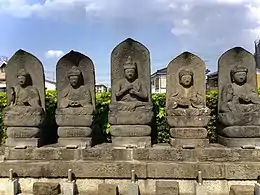 Five Tathagatas in Shishoin Temple (Shibamata, Katsushika, Tokyo) . From the right side, Akshobhya, Ratnasambhava, Vairocana, Amitābha, and Amoghasiddhi
Five Tathagatas in Shishoin Temple (Shibamata, Katsushika, Tokyo) . From the right side, Akshobhya, Ratnasambhava, Vairocana, Amitābha, and Amoghasiddhi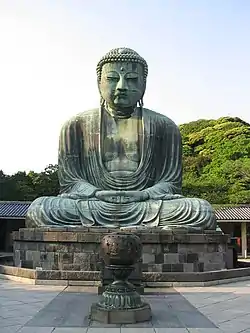 The famous Kamakura Daibutsu, a depiction of Amitabha
The famous Kamakura Daibutsu, a depiction of Amitabha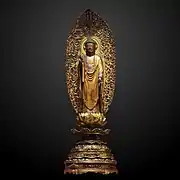 Japanese statuette of Amitabha, 18th century.
Japanese statuette of Amitabha, 18th century.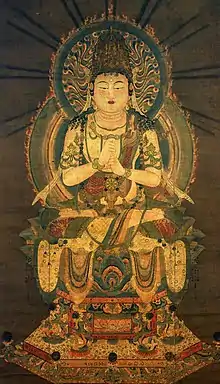 Japanese Painting of Mahavairocana, Heian period, 12th century
Japanese Painting of Mahavairocana, Heian period, 12th century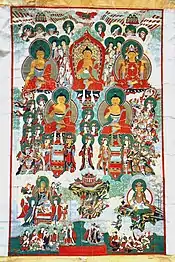 Painting of the Five Buddhas, circa the 6th year under Injo of Joseon Dynasty (1628), Korea
Painting of the Five Buddhas, circa the 6th year under Injo of Joseon Dynasty (1628), Korea Himalayan Buddha Amitayus in His Pure Land, 2nd half of the 18th century
Himalayan Buddha Amitayus in His Pure Land, 2nd half of the 18th century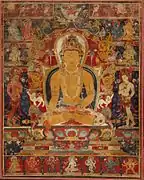 Tibetan painting of Ratnasambhava, circa 1100 and circa 1125
Tibetan painting of Ratnasambhava, circa 1100 and circa 1125_LACMA_AC1994.121.1_(cropped).jpg.webp) Vairochana, From a Set of the Five Jina Buddhas, Central Tibet, circa late 13th - early 14th century
Vairochana, From a Set of the Five Jina Buddhas, Central Tibet, circa late 13th - early 14th century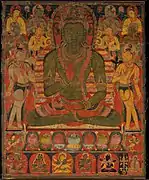 Amoghasiddhi Thangka, Central Tibet circa 1200 –50.
Amoghasiddhi Thangka, Central Tibet circa 1200 –50.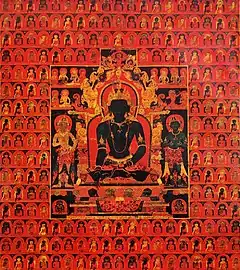 'The Dhyani Buddha Akshobhya', Tibetan thangka, late 13th century.
'The Dhyani Buddha Akshobhya', Tibetan thangka, late 13th century.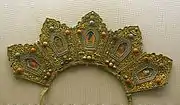 Gilt copper crown with five buddhas, Tibet, 1644-1911 CE.
Gilt copper crown with five buddhas, Tibet, 1644-1911 CE. Ritual Diadem with the Five Jina Buddhas, Northern Nepal or Tibet, 19th century
Ritual Diadem with the Five Jina Buddhas, Northern Nepal or Tibet, 19th century Five Buddhas, Nepal, 16th century
Five Buddhas, Nepal, 16th century.jpg.webp) Statues of the Five Tathagathas, Tri Ratna Buddhist Centre, Pekanbaru, Sumatra
Statues of the Five Tathagathas, Tri Ratna Buddhist Centre, Pekanbaru, Sumatra
See also
References
- Williams, Wynne, Tribe; Buddhist Thought: A Complete Introduction to the Indian Tradition, page 210.
- "香光莊嚴". www.gaya.org.tw. Retrieved 2021-05-12.
- "The Water -Land Dharma Function Platform ritual and the Great Compassion Repentance ritual - ProQuest". www.proquest.com. Retrieved 2021-11-10.
- Bogle (1999) pp. xxxiv-xxxv
- Saunders, E Dale, "A Note on Śakti and Dhyānibuddha," History of Religions 1 (1962): pp. 300-06.
- Japanese Architecture and Art Net Users System. (2004). JAANUS / hokkai jouin 法界定印. Available: http://www.aisf.or.jp/~jaanus/deta/h/hokkaijouin.htm. Last accessed 27 Nov 2013.
- The Śūraṅgama sūtra : a new translation. Hsüan Hua, Buddhist Text Translation Society. Ukiah, Calif.: Buddhist Text Translation Society. 2009. ISBN 978-0-88139-962-2. OCLC 300721049.
{{cite book}}: CS1 maint: others (link) - "Pandara The Shakti of Amitabha". Buddhanature.com. Retrieved 2013-06-14.
- "Mamaki The Shakti of Aksobhya". Buddhanature.com. Retrieved 2013-06-14.
- "chart of the Five Buddhas and their associations". Religionfacts.com. 2012-12-21. Retrieved 2013-06-14.
- Symbolism of the five Dhyani Buddhas Archived March 8, 2009, at the Wayback Machine
- Longchenpa (2014). "XIII". The Great Chariot. p. Part 3e.2a.
- Shumsky, Susan (2010). Ascension: Connecting with the Immortal Masters and Beings of Light. Red Wheel/Weiser. ISBN 978-1-60163-092-6.
Bibliography
- Bogle, George; Markham, Clements Robert; and Manning, Thomas (1999) Narratives of the Mission of George Bogle to Tibet and of the Journey of Thomas Manning to Lhasa ISBN 81-206-1366-X
- Bucknell, Roderick & Stuart-Fox, Martin (1986). The Twilight Language: Explorations in Buddhist Meditation and Symbolism. Curzon Press: London. ISBN 0-312-82540-4
External links
| Wikimedia Commons has media related to Dhyāni Buddha. |
- Five Dhyani Buddhas - chart of the Five Buddhas and their associations.
- StudyBuddhism.com - The Five Buddha-Families and Five Dhyani Buddhas
- Five Dhyani Buddhas Mandala - Thangka painting of the Five Buddhas.
- Symbolism of the five Dhyani Buddhas
- Video demonstration the mantra chanting and mudras used during the Chinese Yogacara Flaming Mouth ceremony (瑜伽焰口法會) to invoke the Five Tathagathas in the ritual space.
- Praise to the Five Buddhas (Chinese: 禮讚五方佛; Pinyin: Lǐzàn Wǔfāngfó), part of the liturgy chanted in certain Chinese monastaries.
- Color Symbolism In Buddhist Art
- Mark Schumacher: Godai Nyorai (Japanese) - Five Buddha of Wisdom Five Buddha of Meditation Five Jina | Five Tathagatas
- The Five Buddha Families - From Journey Without Goal: The Tantric Wisdom of the Buddha by Chögyam Trungpa, Shambhala.org (archived 2007)
- 5 Dhyani Buddhas - 5 Dhyani Buddhas detailed with table
